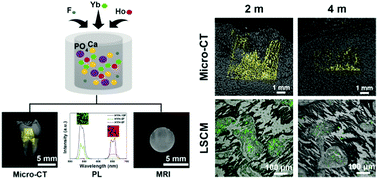A ternary doped single matrix material with dual functions of bone repair and multimodal tracking for applications in orthopedics and dentistry†
Abstract
Hydroxyapatite (HA) has been broadly used for the repair of human hard tissues due to its bioactivity and similarity to the mineral of bones and teeth. We prepared a fluorine (F), ytterbium (Yb) and holmium (Ho) ternary doped HA (HYH-F) material and investigated its dual functions of bone repair and multimodal tracking. The results showed that the HYH-F material could display clear X-ray micro-computed tomography (Micro-CT) images based on Yb ions, and Ho ions due to its superparamagnetic properties for magnetic resonance imaging (MRI), while the F ions could enhance the upconversion (UC) fluorescence of the Yb/Ho combination. The ternary doped HYH-F material shows good compatibility with cells and bone tissue. A joint usage of Micro-CT imaging and UC fluorescence imaging distinctly and synergistically demonstrated the distribution state and degradation of the HYH-F material during new bone reconstruction. The single matrix HA material with ternary doping will be beneficial for future biomedical investigation and applications, and it can not only be a bone repair biomaterial, but also provide lifelong multimodal tracking efficacy.



 Please wait while we load your content...
Please wait while we load your content...